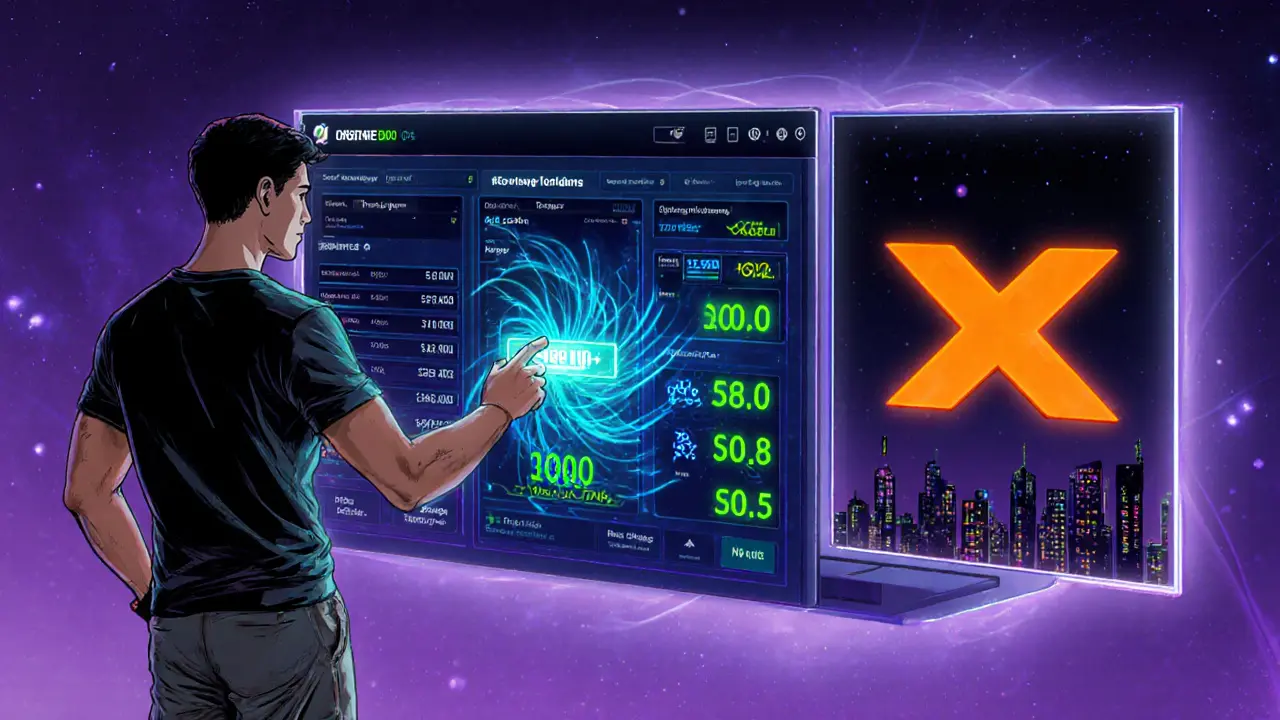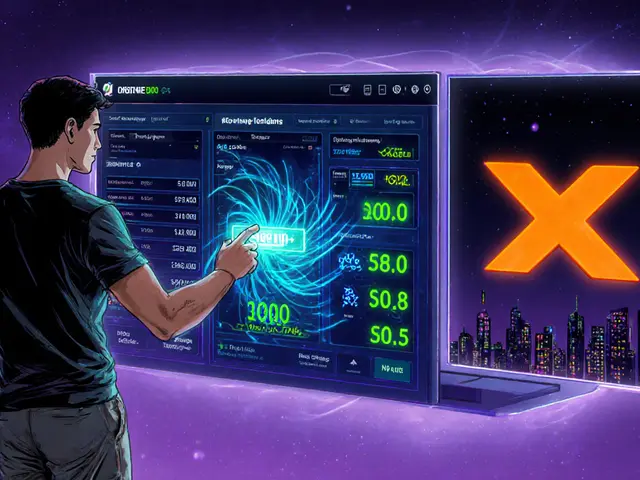Fides Crypto Exchange Fee Calculator
When you stumble upon a new platform like Fides crypto exchange is a cryptocurrency trading venue that markets itself as low‑fee and security‑focused, the first question is: does it actually deliver on those promises? This review pulls apart the most critical pieces - fees, security, available assets, user experience, and regulatory posture - so you can decide in minutes whether to open an account or keep looking elsewhere.
Quick Take (TL;DR)
- Fees: maker‑taker model, 0.10% maker, 0.20% taker, no deposit fees, modest withdrawal charges.
- Security: hardware‑wallet‑cold storage of 95% funds, 2FA mandatory, optional biometric login, recent third‑party audit (no critical findings).
- Assets: 120+ trading pairs, strong BTC/ETH coverage, limited DeFi tokens.
- Regulation: registered in Estonia, adheres to EU AML/KYC standards, no US licence.
- UX: clean web UI, mobile app for iOS/Android, API for bots (REST & WebSocket).
How Fides Stacks Up on Fees
Fee structures are the easiest way to compare exchanges. Fides adopts a maker‑taker model that mirrors many midsize venues. A maker order (providing liquidity) costs 0.10% of the trade value, while a taker order (removing liquidity) is 0.20%. There are no fees for fiat deposits via bank transfer, and crypto deposits are free. Withdrawals carry a flat fee that varies by coin - for Bitcoin it’s 0.0005BTC, for Ethereum 0.005ETH, and ERC‑20 tokens have a $5 minimum.
Compared to industry giants, Fides is cheaper than Coinbase (0.50% taker) but a tad pricier than Binance’s 0.10% taker rate for spot trades. The fee transparency page lists a clear schedule, which is a plus because hidden costs are a common pain point.
Security Measures You Should Expect
Security is non‑negotiable. Fides claims that Security is achieved through multi‑layer encryption, cold storage, and regular audits. Specifically:
- Cold storage: 95% of user funds sit offline in hardware wallets, reducing hack exposure.
- Two‑factor authentication (2FA): Mandatory for withdrawals; supports both authenticator apps and SMS.
- Biometric login (optional): Fingerprint or face ID on the mobile app.
- Annual third‑party audit: Conducted by Quantstamp in 2024, which found no critical vulnerabilities.
- Insurance: A $10million policy covers custodial losses due to theft, though claim conditions apply.
While no exchange is 100% immune, these layers put Fides on par with well‑established players.
Asset Coverage and Liquidity
Having the right trading pairs matters for both convenience and slippage. Fides lists Trading pairs across 120+ cryptocurrencies, including major pairs like BTC/USD, ETH/EUR, and popular altcoins such as SOL, ADA, and DOT. Liquidity is decent on the top 10 pairs, with average spreads under 0.2%, but thin on newer DeFi tokens - expect higher slippage for those.
For traders who need deep order books, the platform offers a Liquidity Provider program that rewards users who add volume with a 10% rebate on maker fees.
Regulatory Standing and Compliance
Fides is incorporated in Estonia and holds an e‑money licence from the Estonian Financial Intelligence Unit. This means it follows EU‑wide anti‑money‑laundering (AML) and know‑your‑customer (KYC) rules. Users must submit a government‑issued ID and proof of address before trading.
The exchange does not currently hold a licence to serve United States residents, and its terms of service explicitly block US IPs. For European users, the Estonian licence offers a reasonable level of consumer protection, though it falls short of the stricter oversight seen in the UK’s FCA‑regulated exchanges.

User Experience: Web, Mobile, and API
The web UI feels lightweight - dashboard widgets let you monitor portfolio, recent trades, and market depth in real time. The User interface is built with React, offering fast load times even on slower connections. The mobile app (available on iOS15+ and Android10+) mirrors the desktop experience, and includes push notifications for price alerts.For algo‑traders, Fides provides a REST API and a WebSocket stream that deliver market data, order placement, and account management endpoints. Documentation is comprehensive, with code snippets in Python, JavaScript, and Go.
Customer Support and Community
Support is reachable via live chat (24/7), email, and a ticketing system. Average response time is under 5 minutes for chat, 30 minutes for email. The help centre hosts over 200 articles covering onboarding, security, and troubleshooting.
Fides also runs an active community on Telegram and Discord, where users share trading ideas and report issues. Moderators are staff members, which helps keep misinformation in check.
Where Fides Excels and Where It Falls Short
| Aspect | Fides | Binance | Coinbase |
|---|---|---|---|
| Maker fee | 0.10% | 0.10% | 0.00% (first $10k) |
| Taker fee | 0.20% | 0.10% | 0.50% |
| Cold storage % | 95% | 98% | 97% |
| Regulatory licence | Estonia (e‑money) | None (global) | USA (NYDFS) |
| Supported pairs | 120+ | 500+ | 150+ |
| Mobile app rating | 4.3/5 | 4.7/5 | 4.5/5 |
In short, Fides nails the basics - solid security, transparent fees, and a decent UI - but it doesn’t yet match the breadth of assets or the brand trust of the biggest exchanges.
How to Get Started on Fides
- Visit Fides.com and click “Sign Up”.
- Enter your email, create a strong password, and agree to the terms.
- Complete the KYC step: upload a passport or driver’s license and a utility bill.
- Enable 2FA via Google Authenticator.
- Deposit crypto or fiat (via SEPA) into your new wallet.
- Navigate to the “Trade” tab, pick a pair, and place a maker or taker order.
All steps are guided by on‑screen prompts, and you can pause the process at any time without losing entered data.
Potential Red Flags to Keep an Eye On
- Limited US access: If you travel often or need to trade from the US, you’ll hit a geo‑block.
- DeFi token coverage: Newest tokens may be missing, forcing you to use a larger exchange.
- Insurance cap: The $10million policy may not cover the full value of large accounts in an extreme event.
These aren’t deal‑breakers, but they’re worth weighing against your personal trading style.
Frequently Asked Questions
Is Fides safe for storing large amounts of crypto?
Fides keeps 95% of assets in cold storage and holds a $10million insurance policy. While no platform is risk‑free, the combination of hardware‑wallet custody, mandatory 2FA, and regular security audits makes it suitable for sizable holdings, provided you follow best practices like using a hardware wallet for the majority of your portfolio.
What are the withdrawal limits on Fides?
Verified users can withdraw up to €100,000 per 24hours. Higher limits require a corporate‑level KYC review, which may take up to five business days to approve.
Can I trade futures or margin on Fides?
As of October2025, Fides offers only spot trading. The roadmap mentions a futures launch in H22026, but no official timeline has been published.
How does Fides compare to Binance on fees?
Both platforms charge a 0.10% maker fee, but Binance’s taker fee is 0.10% versus Fides’ 0.20%. However, Binance’s tiered fee structure can drop to 0.02% for high‑volume traders, while Fides keeps a flat rate. If you trade modest volumes, the difference is minimal.
Is there a mobile app for iOS and Android?
Yes. The app supports iOS15+ and Android10+. It mirrors the web UI, offers push price alerts, and lets you trade, deposit, and withdraw on the go.
Overall, Fides positions itself as a secure, low‑fee alternative for traders who value transparency and EU‑based regulation. It may not have the deep liquidity of the biggest exchanges, but for most retail users the platform delivers everything needed to start trading confidently.




katie sears
October 13 2024Thank you for compiling such a comprehensive overview of Fides; the emphasis on cold‑storage and the $10 million insurance policy is reassuring.
For newcomers, it’s worth noting that mandatory 2FA on withdrawals adds an extra layer of protection, especially when combined with biometric login on the mobile app.
While the fee calculator shows zero fees for the example, users should still verify if promotional periods apply to their specific trade volumes.
I encourage anyone considering Fides to read the third‑party audit report by Quantstamp to fully understand the security posture.
Anil Paudyal
October 15 2024Nice breakdown, but check the withdrawal fee numbers – they might change.
Kimberly Gilliam
October 17 2024Wow the fees look almost too good. Could be a hidden catch.
Jeannie Conforti
October 19 2024Fides seems reliabel and easy to use. Make sure to enable the 2FA for extra safety.
tim nelson
October 21 2024I appreciate the detailed security section; the cold wallet allocation is impressive.
However, users should stay vigilant about phishing attempts despite the strong 2FA.
Overall, it’s a solid option for both beginners and seasoned traders.
Zack Mast
October 23 2024Indeed, the psychological comfort of insurance can be as valuable as the actual coverage.
But one must remember that no system is infallible.
Dale Breithaupt
October 25 2024Pro tip: Keep a small amount of crypto on the exchange for quick trades, move the rest to cold storage.
Rasean Bryant
October 27 2024The user‑interface appears intuitive, and the fee calculator is a handy tool for budgeting.
I foresee many traders benefitting from the transparent fee structure.
Angie Food
October 29 2024Sure, looks slick now, but hidden costs always pop up later.
Don't be fooled by the glossy UI.
Jonathan Tsilimos
October 31 2024The platform's liquidity provision mechanism adheres to industry standards, thereby minimizing slippage during high‑volume trades.
Furthermore, the implementation of mandatory two‑factor authentication aligns with best‑practice security protocols.
Nonetheless, prospective users should conduct a due‑diligence assessment of the underlying smart‑contract architecture.
jeffrey najar
November 2 2024Great points on liquidity and 2FA.
Just add that the API documentation is also well‑structured for developers.
Rochelle Gamauf
November 5 2024While the security metrics are commendable, the insurance coverage of ten million dollars appears modest when considering the total assets under custody.
Additionally, the reliance on a single third‑party audit could be perceived as a single point of verification.
Potential investors might demand more frequent transparency reports.
Jerry Cassandro
November 7 2024Agreed, more frequent audits would boost confidence.
On the bright side, the cold‑wallet ratio is among the highest in the sector.
Parker DeWitt
November 9 2024Sounds good 😏
Allie Smith
November 11 2024Every new exchange adds to the ecosystem's diversity, which ultimately benefits users.
Embracing platforms like Fides can promote healthy competition.
Lexie Ludens
November 13 2024The moment I opened the Fides fee calculator, I felt a surge of hope, as if the crypto world were finally aligning with my financial dreams.
Each zero displayed beside the trading fee was a siren's call, promising cost‑free transactions in a landscape riddled with hidden commissions.
But the romance of zero fees quickly met the cold reality of market volatility, reminding me that no platform can shield me from price swings.
The security section read like a fortress, boasting 95 % cold storage and biometric logins, yet I imagined shadows lurking behind every firewall.
Insurance of ten million dollars sounded generous, but in the grand scheme of institutional capital, it felt like a token offering.
I pictured myself as a lone trader, treading carefully on this digital battlefield, armed with two‑factor authentication as my shield.
The third‑party audit by Quantstamp added a layer of legitimacy, yet I wondered how many eyes truly scrutinized the code.
In the background, whispers of promotional fee structures echoed, suggesting that today’s zero could morph into tomorrow’s surcharge.
The user interface, sleek and modern, seduced me into deeper engagement, while the underlying smart contracts pulsed with unseen complexity.
I found myself torn between optimism and caution, a dichotomy that mirrors the very nature of cryptocurrency itself.
Each withdrawal option-BTC, ETH, ERC‑20-felt like a gateway to freedom, but also a reminder of the transaction fees that could erode profits.
The narrative of Fides promised empowerment, yet empowerment without education can be a perilous illusion.
I reflected on the importance of diversifying across exchanges, a strategy that spreads risk like seeds across fertile soil.
Ultimately, the platform’s transparency in displaying fees, however minimal, earned a sliver of trust in my skeptical heart.
As the calculator refreshed its summary, I resolved to monitor real‑world transactions before fully committing, lest the dream dissolve into regret.
Thus, Fides stands as a promising chapter in my crypto journey, one that must be read with both enthusiasm and a critical eye.
Aaron Casey
November 15 2024The thorough analysis highlights both strengths and blind spots; I concur that monitoring real transaction data is essential.
Additionally, integrating API rate‑limit best practices can further safeguard against abuse.
Leah Whitney
November 17 2024Your breakdown of the fee calculator is spot‑on; have you considered how the promotional periods might affect long‑term cost efficiency?
It would be helpful to see a comparative table with other major exchanges.
Lisa Stark
November 19 2024Comparative analysis indeed provides deeper insight; aligning fee structures with usage patterns can reveal hidden savings.
Such a perspective encourages more informed decision‑making.
Marli Ramos
November 21 2024Looks cool 😎🚀
Christina Lombardi-Somaschini
November 23 2024Indeed, the presentation is commendable; however, the reliance on promotional fee waivers warrants a cautious approach.
Future users should diligently audit the fine print before committing capital.